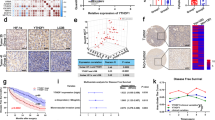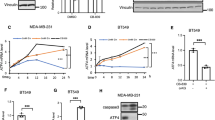Abstract
Activating transcription factor 4 (ATF4) is a transcription factor induced under severe hypoxia and a component of the PERK pathway involved in the unfolded protein response (UPR), a process that protects cells from the negative consequences of endoplasmic reticulum (ER) stress. In this study, we have used small interfering RNA (siRNA) and microarray analysis to provide the first whole-genome analysis of genes regulated by ATF4 in cancer cells in response to severe and prolonged hypoxic stress. We show that ATF4 is required for ER stress and hypoxia-induced expansion of autophagy. MAP1LC3B (LC3B) is a key component of the autophagosomal membrane, and in this study we demonstrate that ATF4 facilitates autophagy through direct binding to a cyclic AMP response element binding site in the LC3B promoter, resulting in LC3B upregulation. Previously, we have shown that Bortezomib-induced ATF4 stabilization, which then upregulated LC3B expression and had a critical role in activating autophagy, protecting cells from Bortezomib-induced cell death. We also showed that severe hypoxia stabilizes ATF4. In this study, we demonstrate that severe hypoxia leads to ER stress and induces ATF4-dependent autophagy through LC3 as a survival mechanism. In summary, we show that ATF4 has a key role in the regulation of autophagy in response to ER stress and provide a direct mechanistic link between the UPR and the autophagic machinery.
This is a preview of subscription content, access via your institution
Access options
Subscribe to this journal
Receive 50 print issues and online access
$259.00 per year
only $5.18 per issue
Buy this article
- Purchase on Springer Link
- Instant access to full article PDF
Prices may be subject to local taxes which are calculated during checkout







Similar content being viewed by others
References
Ameri K, Lewis CE, Raida M, Sowter H, Hai T, Harris AL . (2004). Anoxic induction of ATF-4 through HIF-1-independent pathways of protein stabilization in human cancer cells. Blood 103: 1876–1882.
Averous J, Bruhat A, Jousse C, Carraro V, Thiel G, Fafournoux P . (2004). Induction of CHOP expression by amino acid limitation requires both ATF4 expression and ATF2 phosphorylation. J Biol Chem 279: 5288–5297.
Azad MB, Chen Y, Henson ES, Cizeau J, McMillan-Ward E, Israels SJ et al. (2008). Hypoxia induces autophagic cell death in apoptosis-competent cells through a mechanism involving BNIP3. Autophagy 4: 195–204.
Bernales S, McDonald KL, Walter P . (2006). Autophagy counterbalances endoplasmic reticulum expansion during the unfolded protein response. PLoS Biol 4: e423.
Bi M, Naczki C, Koritzinsky M, Fels D, Blais J, Hu N et al. (2005). ER stress-regulated translation increases tolerance to extreme hypoxia and promotes tumor growth. EMBO J 24: 3470–3481.
Blais JD, Addison CL, Edge R, Falls T, Zhao H, Wary K et al. (2006). Perk-dependent translational regulation promotes tumor cell adaptation and angiogenesis in response to hypoxic stress. Mol Cell Biol 26: 9517–9532.
Graeber TG, Osmanian C, Jacks T, Housman DE, Koch CJ, Lowe SW et al. (1996). Hypoxia-mediated selection of cells with diminished apoptotic potential in solid tumours. Nature 379: 88–91.
Harding HP, Zhang Y, Ron D . (1999). Protein translation and folding are coupled by an endoplasmic-reticulum-resident kinase. Nature 397: 271–274.
Harding HP, Zhang Y, Bertolotti A, Zeng H, Ron D . (2000). Perk is essential for translational regulation and cell survival during the unfolded protein response. Mol Cell 5: 897–904.
Harding HP, Zhang Y, Zeng H, Novoa I, Lu PD, Calfon M et al. (2003). An integrated stress response regulates amino acid metabolism and resistance to oxidative stress. Mol Cell 11: 619–633.
Harris AL . (2002). Hypoxia—a key regulatory factor in tumour growth. Nat Rev Cancer 2: 38–47.
He H, Dang Y, Dai F, Guo Z, Wu J, She X et al. (2003). Post-translational modifications of three members of the human MAP1LC3 family and detection of a novel type of modification for MAP1LC3B. J Biol Chem 278: 29278–29287.
Karpinski BA, Morle GD, Huggenvik J, Uhler MD, Leiden JM . (1992). Molecular cloning of human CREB-2: an ATF/CREB transcription factor that can negatively regulate transcription from the cAMP response element. Proc Natl Acad Sci USA 89: 4820–4824.
Koumenis C, Naczki C, Koritzinsky M, Rastani S, Diehl A, Sonenberg N et al. (2002). Regulation of protein synthesis by hypoxia via activation of the endoplasmic reticulum kinase PERK and phosphorylation of the translation initiation factor eIF2alpha. Mol Cell Biol 22: 7405–7416.
Kouroku Y, Fujita E, Tanida I, Ueno T, Isoai A, Kumagai H et al. (2007). ER stress (PERK/eIF2alpha phosphorylation) mediates the polyglutamine-induced LC3 conversion, an essential step for autophagy formation. Cell Death Differ 14: 230–239.
Kroemer G, Jaattela M . (2005). Lysosomes and autophagy in cell death control. Nat Rev Cancer 5: 886–897.
Kuma A, Hatano M, Matsui M, Yamamoto A, Nakaya H, Yoshimori T et al. (2004). The role of autophagy during the early neonatal starvation period. Nature 432: 1032–1036.
Lu PD, Jousse C, Marciniak SJ, Zhang Y, Novoa I, Scheuner D et al. (2004). Cytoprotection by pre-emptive conditional phosphorylation of translation initiation factor 2. EMBO J 23: 169–179.
Lum JJ, Bauer DE, Kong M, Harris MH, Li C, Lindsten T et al. (2005). Growth factor regulation of autophagy and cell survival in the absence of apoptosis. Cell 120: 237–248.
Milani M, Rzymski T, Mellor HR, Pike L, Bottini A, Generali D et al. (2009). The role of ATF4 stabilization and autophagy in resistance of breast cancer cells treated with Bortezomib. Cancer Res 69: 4415–4423.
Mizushima N, Yamamoto A, Matsui M, Yoshimori T, Ohsumi Y . (2004). in vivo analysis of autophagy in response to nutrient starvation using transgenic mice expressing a fluorescent autophagosome marker. Mol Biol Cell 15: 1101–1111.
Mujcic H, Rzymski T, Rouschop KM, Koritzinsky M, Milani M, Harris AL et al. (2009). Hypoxic activation of the unfolded protein response (UPR) induces expression of the metastasis-associated gene LAMP3. Radiother Oncol 92: 450–459.
Ogata M, Hino S, Saito A, Morikawa K, Kondo S, Kanemoto S et al. (2006). Autophagy is activated for cell survival after endoplasmic reticulum stress. Mol Cell Biol 26: 9220–9231.
Ohoka N, Yoshii S, Hattori T, Onozaki K, Hayashi H . (2005). TRB3, a novel ER stress-inducible gene, is induced via ATF4-CHOP pathway and is involved in cell death. EMBO J 24: 1243–1255.
Olive PL, Banath JP, Durand RE . (2002). The range of oxygenation in SiHa tumor xenografts. Radiat Res 158: 159–166.
Papandreou I, Krishna C, Kaper F, Cai D, Giaccia AJ, Denko NC . (2005). Anoxia is necessary for tumor cell toxicity caused by a low-oxygen environment. Cancer Res 65: 3171–3178.
Rouschop KM, van den Beucken T, Dubois L, Niessen H, Bussink J, Savelkouls K et al. (2009). The unfolded protein response protects human tumor cells during hypoxia through regulation of the autophagy genes MAP1LC3B and ATG5. J Clin Invest 120: 127–141.
Rzymski T, Paantjens A, Bod J, Harris AL . (2008). Multiple pathways are involved in the anoxia response of SKIP3 including HuR-regulated RNA stability, NF-kappaB and ATF4. Oncogene 27: 4532–4543 .
Rzymski T, Milani M, Singleton DC, Harris AL . (2009). Role of ATF4 in regulation of autophagy and resistance to drugs and hypoxia. Cell Cycle 8: 3838–3847.
Sarkar S, Perlstein EO, Imarisio S, Pineau S, Cordenier A, Maglathlin RL et al. (2007). Small molecules enhance autophagy and reduce toxicity in Huntington's disease models. Nat Chem Biol 3: 331–338.
Scheuner D, Song B, McEwen E, Liu C, Laybutt R, Gillespie P et al. (2001). Translational control is required for the unfolded protein response and in vivo glucose homeostasis. Mol Cell 7: 1165–1176.
Semenza GL . (2003). Targeting HIF-1 for cancer therapy. Nat Rev Cancer 3: 721–732.
Semenza GL . (2008). Mitochondrial autophagy: life and breath of the cell. Autophagy 4: 534–536.
Shimizu S, Kanaseki T, Mizushima N, Mizuta T, Arakawa-Kobayashi S, Thompson CB et al. (2004). Role of Bcl-2 family proteins in a non-apoptotic programmed cell death dependent on autophagy genes. Nat Cell Biol 6: 1221–1228.
Shintani T, Klionsky DJ . (2004). Autophagy in health and disease: a double-edged sword. Science 306: 990–995.
Tu BP, Weissman JS . (2004). Oxidative protein folding in eukaryotes: mechanisms and consequences. J Cell Biol 164: 341–346.
Wenger RH, Gassmann M . (1996). Little difference. Nature 380: 100.
Wouters BG, Brown JM . (1997). Cells at intermediate oxygen levels can be more important than the ‘hypoxic fraction’ in determining tumor response to fractionated radiotherapy. Radiat Res 147: 541–550.
Wu J, Dang Y, Su W, Liu C, Ma H, Shan Y et al. (2006). Molecular cloning and characterization of rat LC3A and LC3B—two novel markers of autophagosome. Biochem Biophys Res Commun 339: 437–442.
Yamamoto A, Tagawa Y, Yoshimori T, Moriyama Y, Masaki R, Tashiro Y . (1998). Bafilomycin A1 prevents maturation of autophagic vacuoles by inhibiting fusion between autophagosomes and lysosomes in rat hepatoma cell line, H-4-II-E cells. Cell Struct Funct 23: 33–42.
Yorimitsu T, Nair U, Yang Z, Klionsky DJ . (2006). Endoplasmic reticulum stress triggers autophagy. J Biol Chem 281: 30299–30304.
Acknowledgements
We thank Dr S Colella for help with initial microarray data analysis. We also thank Dr P Thomas for his help in using the confocal microscope and Dr D Singleton for critical revision of the paper.
Author information
Authors and Affiliations
Corresponding author
Ethics declarations
Competing interests
The authors declare no conflict of interest.
Additional information
Supplementary Information accompanies the paper on the Oncogene website
Rights and permissions
About this article
Cite this article
Rzymski, T., Milani, M., Pike, L. et al. Regulation of autophagy by ATF4 in response to severe hypoxia. Oncogene 29, 4424–4435 (2010). https://doi.org/10.1038/onc.2010.191
Received:
Revised:
Accepted:
Published:
Issue Date:
DOI: https://doi.org/10.1038/onc.2010.191
Keywords
This article is cited by
-
Advances in the study of autophagy in breast cancer
Breast Cancer (2024)
-
Impact of context-dependent autophagy states on tumor progression
Nature Cancer (2023)
-
Induction of proteasomal activity in mammalian cells by lifespan-extending tRNA synthetase inhibitors
GeroScience (2023)
-
Dual RNase activity of IRE1 as a target for anticancer therapies
Journal of Cell Communication and Signaling (2023)
-
Transcriptome profile of spleen tissues from locally-adapted Kenyan pigs (Sus scrofa) experimentally infected with three varying doses of a highly virulent African swine fever virus genotype IX isolate: Ken12/busia.1 (ken-1033)
BMC Genomics (2022)



